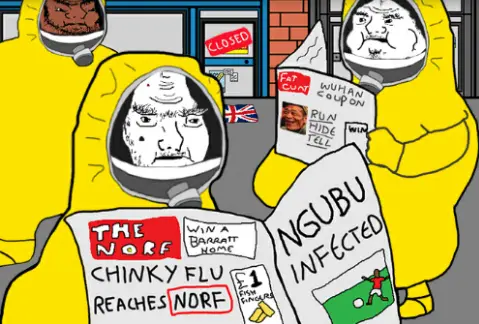Was the Third Reich a Collection of Meth-Spun Tweakers?
THE REAL STORY OF METHAMPHETAMINES IN THE THIRD REICH
For decades now, there has been a fair amount of Jewish/Communist smear propaganda floating around alleging that there was widespread abuse of meth amphetamines by Germans during World War II. The easiest way to counteract these lies is simply by telling the truth, which is not complicated. Due to the current miserable state of human so-called intelligence, the Jews know that if they say anything bad about Germans or the Third Reich in general, then even the most scurrilous flapdoodle is going to be automatically believed without question and without any need for proof. Especially if it comes from a Jew, a character assassination against the Third Reich is easily thwarted by presenting simple historical facts and by doing a bit of cursory historical research.
First, let us state the obvious — methamphetamines are stimulants, and these substances were widely used by All belligerents during World War II, and these chemicals were used by every army fighting in World War II for all the same reasons. Even today, various types of methamphetamines are still used by militaries to counteract fatigue and hunger in emergency situations. I will give specific examples of how methamphetamines were used by the Third Reich shortly.
Opium Goes to War – Make the Hurt Feel Good
PBS.org notes in an article called Opium Kings that the Sumerians cultivated opium poppies as early as 3400 B.C and the ancient Egyptians cultivated huge fields of opium poppies beginning around 1300 B.C. Opium’s ability to counter pain and treat dangerous dehydrating diarrhea from dysentery has also been known for thousands of years, so mixtures of opium and wine, or various mixtures of smokable opium have been carried as battle medicine by many armies for quite some time. Post-Traumatic Stress Disorder, or “Battle Fatigue” as it is also known, has been a fixture of war since time began, anxiety and depression brought about by combat and the general living privations associated with going to war are nothing new either, and opium has been one thing that soldiers have used to counter the stressful effects of war for a long time.
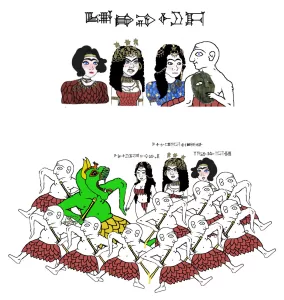

The point we are making here is that dangerous and addictive narcotics have been part of military campaigns for thousands of years now; however, methamphetamines made their debut in World War II, and these stimulants are still used by militaries to this day. Recover.org notes that the American military issued soldiers millions of doses of potent and very addictive methamphetamines during the Viet Nam War, so World War II marked the debut of military methamphetamine use, but World War II certainly did not mark the end of military methamphetamine use.
The recover.org website notes that more than 400,000 veterans of the American Civil War retained an opioid addiction in the years after the war’s conclusion, so narcotics and war have always gone together to one degree or another. In the American Civil War, opium was used to counter the effects of dysentery and to help soldiers cope with pain more effectively. Morphine was first synthesized from opium in 1832, and as noted on the National Library of Medicine’s website, French physician Charles-Gabriel Pravaz introduced the piston syringe in 1853, and soon afterward Scottish physician Alexander Wood used Pravaz’s invention to administer inter-venous morphine injections. The hypodermic needle and morphine were both around during the American Civil War, so this was the first military campaign that saw injections of morphine used in army hospitals and as emergency battlefield medicine. We should also note that almost every hospital around the world now stocks legally produced and very pure supplies of morphine that are mostly used to alleviate pain following surgery. A new 2018 study conducted by the University of Colorado at Boulder suggests that prolonged morphine use my actually slow healing after major surgeries, but the pain relief aspects of morphine still make this medication valuable from a medical standpoint.

World War I also saw plenty of medical morphine doses administered, and plenty of non-medical morphine doses consumed as well. In 1894 Charles Romley Alder Wright, an English chemist and physicist, synthesized diacetylmorphine and named it Heroin, so Heroin addiction was a thing during and after World War I.

The medical syringe came into being in the 1850s and morphine was around as well at this time, so in World War I, syringes filled with morphine were regulated and issued to medical personnel on the front lines and working in military hospitals, but inevitably, doses of morphine made their way into the hands of non-medical personnel who consumed this substance for non-medical reasons. Not surprisingly, World War I veterans were plagued by opioid addiction like war veterans have been since Biblical times.

Methamphetamines may get more attention, but every army that fought in World War II also stocked plenty of morphine, so if we are to have a meaningful discussion about the Third Reich using methamphetamines, then we must also look at prescribed opioid use for military purposes during that same conflict. It is also worth noting that the American military issued millions of self-administered pre-packaged morphine kits to their soldier during World War II, so every army that fought in World War II made use of morphine. In the years after World War I, morphine or other types of opioids were deemed essential supplies for a modern army or for modern hospitals that were performing surgery, so many chemists began looking for synthetic alternatives to morphine because during World War I, opium supplies were still mostly imported from outside of Europe; therefore, there was a perceived need to develop synthetic opioids that could be made locally.
The National Medical Library’s website notes that in 1914 German chemists developed Oxymorphone, but the synthetic morphine alternative most used by the Third Reich’s military was Meperidine which was patented in 1932. Hydrocodone was developed in 1943, but very little of this synthetic opioid ever appeared on the battlefield. Hydrocodone led to the eventual development of the drug now commonly called Methadone. Beginning in the 1960’s Methadone started being administered as a way of treating people who were addicted to Heroin. Methadone maintenance is typically performed by administering one dose of this drug orally each day, methadone is a slow-acting opioid that does not deliver the same rush as injected heroin, but Methadone does help prevent opioid withdrawal and cravings.

Image of Sid and Nancy furnished courtesy of newyourpost.com
The “Forced March” of World War I — “Cocaine is a Hell of a Drug!”
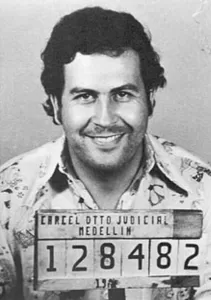
Image of Pablo Escobar furnished courtesy of LadBible.com
The encyclopedia.1914-1918-online.net website notes that the German pharmaceutical company Merck of Darmstadt isolated cocaine from coca leaves in 1859, then Merck began marketing purified cocaine to the public that same year. In 1883, a Bavarian physician named Theodore Aschenbrandt tested the effects of cocaine on soldiers doing field training. Aschenbrandt theorized that regularly administering cocaine to soldiers would reduce a military’s need for food by as much as 20%. Aschenbrandt also took a keen interest in cocaine’s ability to combat sleepiness and physical exhaustion which are so common to soldiers serving a wars. In 1890, cocaine hit the public market in Britain, and the British company Burroughs Wellcome & Co. of London began marketing gelatin capsules filled with cocaine and cola nut powder under the trade name “Forced March.” Forced March pills were used quite liberally during early explorations of Antarctica, so it comes as no surprise that the British Army used these same pills quite liberally during World War I.
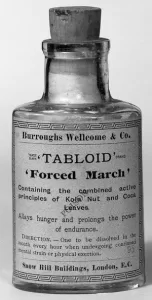
The enclyclopedia.1914-1918-online.net also notes that behind the lines in both France and England, the years of World War I saw a lot of cocaine use amongst soldiers, so the British and French soldiers were known to smuggle powdered cocaine back to the front lines from Paris and London. Care packages from wives, girlfriend, and family members that were sent to British and French soldiers fighting on the front lines were also notorious for being filled with copious amounts of cocaine that was legally purchased at pharmacies. The famous British department store named Harrods, as well as the respected British pharmacy chain named Savory & Moore, both sold dedicated care packages for soldiers that were filled with powdered cocaine along with syringes and vials of pure morphine. Cocaine use on the front lines in World War I was commonly done to stave off hunger, depression, and boredom, and fatigue, but soldiers were also known to snort cocaine to fortify their courage before charging enemy lines.

Image courtesy of makeameme.org
It is also worth noting that cocaine derivatives work well as an injectable localized anesthetic, so the British army used plenty of cocaine-filled syringes to alleviate localized pain such as burns and bullet wounds. On 15 September 1885, the Austrian physician named Joseph Brettauer perfected a local anesthetic made from a solution of 2% cocaine and hydrochloride and the rest consisting of a common saline solution, and earlier that year other less effective cocaine mixtures were used as local anesthesia for minor eye and dental surgery, so 1885 cemented cocaine’s status as a local anesthetic.

Cocaine use during World War I was pretty much non-existent on the German side because Germany was embargoed and therefore cut-off from any overseas cocaine imports during this time. During World War I, the Netherlands maintained neutrality during the conflict, so Dutch-ran cocaine plantations in the Dutch East Indies (Indonesia) did brisk business. The Dutch introduced cocaine to the island of Java in 1878, and it was these Dutch cocaine plantations that fed World War I’s cocaine cravings outside of Germany and the Austro-Hungarian Empire.
A Snapshot of Methamphetamine Use in the 1930s
Opioid addiction is an ancient phenomenon that dates back to the Roman empire and the old Greek city states, so opioid addiction was a familiar and well-understood phenomenon back in the 1930s, as was cocaine; however, methamphetamines were not a familiar and well-understood phenomenon back then. As of the 2020s, methamphetamines are not seen by the public as a useful tool with great applications, nor are methamphetamines viewed by the general public as an unfamiliar novelty. In the 2020s methamphetamines are a familiar vice that is viewed as a dangerous and addictive drug which hooks its users in cycles of addiction that lead to destroyed lives and ruined health. In the 2020s, methamphetamines are viewed in the same light as heroin; namely, as an addictive and dangerous narcotic, but familiarity with of the dangers of methamphetamines use was not always clear to the public nor to the medical establishment.
Nicolas Racine wrote a paper that he delivered to an undergraduate research conference at James Madison University in 2019, and this paper notes that in 1887 the Romanian chemist Lazar Edeleanu developed a synthetic compound which mimicked the effects of the natural stimulant ephedrine. In the years following Edeleanu’s work, other chemists experimented with artificial stimulants, but it was not until 1919 that the Japanese chemist named Akira Ogata developed what is today the familiar drug of methamphetamines. Racine mentions that in 1910, two American physicians named George Barger and Henry Dale tested synthetic stimulants on animals and American experiments with human test subjects progressed throughout the 1920s and 1930s.

In 1933 the American pharmaceutical company Smith, Kline, and French (SKF) began marketing Benzadrine inhalers to the public as a decongestant, and this same company began selling Benzadrine “pep” pills to the general public at pharmacies, and sales of these “over-the-counter” amphetamine “pep” pills progressed until the American medical establishment became more acutely aware of the true dangerous effects of this drug around 1959.
Smithsonian magazine published an October 2017 article called A Speedy History of America’s Addiction to Amphetamine, and in this article, the author Erin Blakemore notes that methamphetamines did not become a true recognized Schedule II narcotic along the same lines as heroin or cocaine in America until 1970! Blakemore also notes that methamphetamines may have become regulated in 1959, but they were readily available by doctor’s prescription in the 1960s, and millions of American women visited diet pill clinics in the 1960’s that dispensed colorful prescription doses of methamphetamines mostly for weight loss, but also to combat depression. The pills dispensed at these pill clinics were deliberately made as colorful and visually appealing as possible in an attempt to disarm feelings of caution or misapprehension about taking these pills for their female customers.

Despite its notable addictive qualities, methamphetamines do suppress a person’s appetite and speed up a person’s metabolism, which in turn does help promote weight loss; however, prolonged use of methamphetamines leads to muscles loss and wasting due to creating increased metabolism and decreased caloric intake. Methamphetamine use does lead to slow muscle wasting on account of methamphetamine’s well-known appetite suppression effects combined with increased calorie metabolism. Not surprisingly, these American boutique prescription methamphetamine clinics minted millions of new addicts in the 1960s. Blakemore notes that by 1970, 5% of all Americans were taking prescription methamphetamine pills with an estimated 3.2 million Americans having developed a true addiction to their prescription speed pills.

Today, the American Justice Department’s website estimates that as of 2021 around 5% of all of America’s high school seniors have used potent and very addictive methamphetamines at some point, and 3% of American high school seniors use this dangerous drug regularly. Recent television shows such as Breaking Bad and Yellowstone, along with the arthouse movies such as Spun and Requiem for a Dream, have done their share to raise public consciousness about the dangers of methamphetamine addiction, so the dangers of methamphetamine use are increasingly well-known to the general public.

As of the 2020s, people are very well aware of the deleterious effects wrought by methamphetamines, but Racine notes that early research with methamphetamines in the 1930s uncovered a surprising list of provable advantages associated with using these drugs. The advantages offered by amphetamine use include: increased confidence, increased energy, increased alertness, much longer attention spans, increased memory retention, increased immune system functioning, and methamphetamines boosted scores on all intelligence tests. It seems that prolonged use of methamphetamines does lead to mental and physical deterioration for its users, but for those who use these drugs infrequently these substances bring measurable benefits.
It has been proven that university students who take methamphetamines can actually study with laser-like focus for periods of days without needing sleep or food, but such use of amphetamines always puts the people who do these sorts of things at serious risk of developing addiction, and all of the mental and physical deterioration that come with it. Despite its problems, methamphetamines certainly can give users increased focus and increased ability to disregard fatigue, hunger, and demoralization, well at least for the short term.

Racine’s paper notes that the British Royal Airforce worked with Dr. Roland Winfield and Dr. Frederick Bartlett and ran tests on Benzadrine’s effects on combat pilots who were study volunteers, and these British researchers noted that amphetamines did not improve their subjects’ abilities so much as permit them to function at acceptable levels for much longer periods of time without being debilitated by fatigue, hunger, or demoralization. In other words, methamphetamine boosts moral and halts performance deterioration, for a while at least. We are saying “for a while at least” in this case because prolonged methamphetamine use leads to psychosis and physical deterioration. Winfield and Bartlett also noted that Benzadrine helped British aircrews counteract the effects of oxygen deprivation due to altitude.
Racine’s paper also notes that during World War II, Benzadrine helped British combat pilots and soldiers overcome morale problems and fatigue during prolonged periods of combat. Racine’s additionally mentions that on many occasions British bomber pilots testified that they needed to be jacked up on methamphetamines to find the confidence they needed to complete very risky bombing missions over German cities — these pilots attested that they would have turned back for sure on many occasions if they did not have Benzadrine coursing through their bodies.

As Racine notes, the American military records from World War II indicate that many soldiers froze from fear and uncertainty when they first experienced combat; however, those who were taking Benzadrine at the time were far more likely to fire at the enemy during the start of combat, and these amphetamine-dosed soldiers were also far less likely to feel anxiety during battles or trauma at the end of battles. Despite its problems, the euphoria-inducing effects of Benzadrine did help its users stave off morale problems and the debilitating effects of post-traumatic stress disorder.
It is worth noting at some point that Nicholas Racine’s paper mentions that there is still no conclusive proof that the German army’s early Blitzkrieg military campaigns during the early part of World War II were truly fueled by amphetamine use. Racine writes that even those with a true ideological axe to grind against the Third Reich are still hard-pressed to find their “Smoking Gun” or “Gotcha Moment” which proves that the Third Reich’s Blitzkrieg campaigns in Poland, France, and other places were truly fueled by Purvatin. The only tangible evidence that the Blitzkrieg was fueled by methamphetamines seems to be based on how the Germans covered so much ground in such short spans of time; however, this evidence is not definitive proof of amphetamine use. Also, let it be said that even if the smashing success of the early-war Blitzkrieg campaigns was at least partially fueled by methamphetamine use, the German military were far from the only ones who were using some type of methamphetamines during World War II. Truth is, any finger-pointing and accusations about “meth-spun” soldiers on the German side during World War II constitutes a clear-cut case of the pot calling the kettle black.

In conclusion, methamphetamines do offer soldiers serving in wars some critical advantages…provided they only take these drugs in emergency situations. Indeed, methamphetamines will help soldiers keep going when the effects of fatigue and hunger are debilitating and a loss of morale will prove fatal. And yes, losing moral when being chased and hunted, or when being pinned in place by distance weapons, can constitute a fatal problem because in cases such as these, the people who survive these ordeals persevere because they have have gung-ho, die-hard, and can-do kinds of mindsets. The long-term effects of methamphetamine use include addiction, heart damage, pancreatic cancer, psychosis, and muscle wasting; therefore, the long-term use of amphetamines is truly detrimental; however, the short-term effects of methamphetamines have provable and beneficial military applications.

The Pot Calling the Kettle Black: Did the “Allies” and Other Forces also use Amphetamines during World War II?
The website recover.org notes that the British found tablets of Pervatin in a crashed German fighter aircraft which they recovered in the South of England in 1940. The British examined the tablets found in the crashed German airplane, then quickly began to issue their own version of Pervatin which was named Benzadrine. Interestingly, a time.com article from January 7, 2020 notes that the German sports establishment suspected the reason why the Americans made such an unusually strong showing at the 1936 Berlin Olympics was due to their athletes gaining a doping advantage by using the American-developed stimulant known as Benzadrine. In response to the perceived advantages offered by stimulants such as Benzadrine, the German chemist named Friedrich Hauschild developed Pervatin while working for the Berlin-based pharmaceutical company named Temmler-Werke. Hauschild patented Pervatin in the winter of 1937.
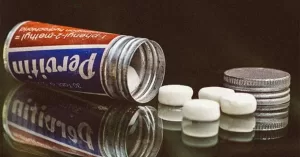
Recovery.org also notes that by beginning of 1941, the British Royal Airforce was issuing tins of Benzadrine pills and Benzadrine inhalers to their combat pilots. A June 10, 2019 article published on thirteen.org notes that the American military issued more than 500 million individual Benzadrine tables to their soldiers before World War II ended, and recovery.org notes that around 15% of American military personnel were taking Benzadrine regularly during their time serving throughout World War II. Nicholas Racine additionally writes that 16 million American military personnel took Benzadrine at some point during their World War II service. It is worth citing the fact that British General Montgomery issued 100,000 Benzadrine tablets to British Army members before the second battle of Al Alamein in North Africa during 1942. A September 27, 2022 article in JSTOR.org written by Mathew Wills notes that the British military ordered 78 million Benzadrine pills during World War II, and the Third Reich is estimated to have produced around 275 million Pervatin pills between 1938 and 1945, but the number of Soviet (DNP) “Heat Pills” consumed during World War II is less well known; however, the number has to be very large.
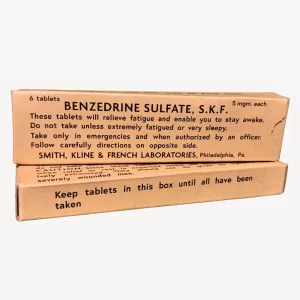
The old Soviet army also issued huge quantities of methamphetamine derivatives to their soldiers during World War II, except the Soviet Union’s drug of choice was 2,4-Dinitrophenol or (DNP). As noted in wearethemighty.com’s October, 30, 2020 article by Blake Stillwell, the Soviets called their versions of Benzadrine or Pervatin, “Heat Pills” and the idea was that these pills could be taken to fight off cold. It seems that the Soviet Union made liberal, and often fatal, use of DNP, but evidence of methamphetamines use is harder to locate. DHP often induced heart attacks and hypothermia and heat stroke in Russian soldiers, so it is not certain how helpful these pills really were over the course of World War II.

Image of old Soviet DNP pills furnished courtesy of wearethemighty.com
On the other hand, an April 2023 article written by Kevin Martin notes that Imperial Japan produced an estimated one billion amphetamine pills between 1939 and 1945, and following the war, Japan has at least 500,000 methamphetamine addicts. The Japanese called their speed pills “Philopon” which was derived from the Greek word “Philo” which loosely translates to “love” or “liking” in English and “Pon” is short for Ponos who was the Greek God of work and hard labor. So, the Japanese “Philopon” name for their military issued methamphetamine tablets would translate to English as “Love Labor.” Although the Germans may be smeared the worst for using stimulants during World War II, The Japanese were by far the most prolific users of methamphetamines during that era.

A November 2016 article published by Al Jazeera that was written by Barbara McCarthy notes that in the years following World War II, a House Select Committee on crime discovered the American military issued 225 million amphetamine pills to military personnel between 1966 and 1969 alone.

McCarthy also states that the more recent civil war in Syria has been marked by huge amounts of Captagon pills consumed on all combatant sides. The Syrian civil war officially started in on March 15, 2011, but hostilities smolder to this day, and Wikipedia.org’s write up on Captagon now openly accuses Syria’s Assad government of exporting $57 Billion worth of Captagon annually as a means of propping up Syria’s government. We should also mention that Captagon use is not limited to military activities and armed conflicts in the Middle East, it turns out that the entire Middle East from Pakistan to Morocco has a notable issue with Captagon use in general; however, this type of amphetamine certainly finds its way into conflict zones.

It seems that Captagon pills will continue to be consumed so long as hostilities smolder in Syria. McCarthy notes that in 2015 Syrian customs officials seized 11 million Captagon pills coming in from Turkey and a shipment of 1.5 million Captagon pills from Kuwait, but this is just the shipments intercepted, so far more of this pills were consumed during 2015 alone. The point to consider is that methamphetamine use in military contexts is by no means confined to the Third Reich or to World War II.

Randall Hilburn Discusses Amphetamine Use in the Third Reich
Before I address the Third Reich’s use of stimulants, however, I wish to clear up the same lies that are now being spread about the Japanese Kamikaze pilots of World War II. There is simply ZERO actual proof that Japanese Kamikaze pilots were all high as fuck on methamphetamines during their suicide missions! NO, the Kamikazes were not all high on meth as the Jews are now claiming. Japan’s World War II Kamikaze pilots were all very sober and very much in control of themselves during Kamikaze missions.
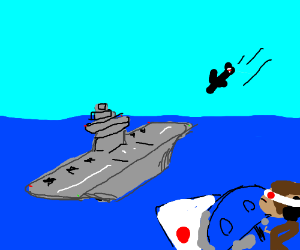
It also used to be said by (((American propaganda))) outlets that Japanese Kamikaze pilots all got roaring drunk before their last mission. During World War II, American films were shown endlessly that showed Kamikazes drinking saki (Japanese rice wine) before boarding their planes. What was actually happening was that the pilots were drinking a final toast to the health of the Emperor before embarking on a potential Kamikaze combat aircraft mission, the traditional pre-flight toast to the Emperor’s health consisted of a very small cup of saki, and this toast was always done before a potential kamikaze flight.
It is a largely suppressed fact that around half of all Kamikaze sorties were actually recalled before reaching their targets. Landing an aircraft on an aircraft carrier is a rather demanding activity even when one is very well-trained and stone-cold sober, so such an activity is even more challenging when the pilot is roaring drunk.
An amusing aside: I read the personal account of one Kamikaze pilot who survived the war because he had been recalled from a kamikaze mission. At that time, he was a 17-year-old high school student who volunteered for the Kamikazes. He had never tasted alcohol in his life before he drank his fist toast to the Emperor’s health before his assigned kamikaze combat mission. This young pilot had only tasted alcohol before his first combat mission because he and others of his age group were considered under-aged when it came to drinking.

The Weimar Republic and Drugs
When Adolf Hitler became Germany’s Chancellor, Weimar Berlin was the undisputed drug capital of Europe. Of course, the illicit drug trade in Weimar Germany was a JEWISH MONOPOLY. To understand how Weimar Berlin became so filled with illicit drugs, one must first analyze the Jewish Bolshevik takeover of Russia.
The Jewish Bolshevik takeover of Russia happened in three distinct phases: The Russian Revolution, The Bolshevik Revolution, and the Russian Civil War.
(1) Russian Revolution. This “revolution” began as a popular rebellion against the great privations brought about on the general Russian population as a consequence of the Russian Empire’s disastrous involvement in World War I. Initially the purpose of this uprising was to end Russia’s involvement in World War I, not necessarily overthrow the Czar.
(2) Bolshevik Revolution. The Jewish Bolsheviks seized control of the already ongoing revolution with the same well-known and disastrous results that we have come to expect from all Jewish activities.
(3) Russian Civil War. The Russian Civil War grew out of what amounted to a civil war within the International Jewish Banking establishment. This conflict was between the Jewish bankers who financed the Bolshevik takeover and those who had come to oppose it. (For reasons I have discussed in an earlier blog.) The faction of Jewish bankers who were opposed to the Bolshevik takeover of Russia pushed a number of countries into intervening against the Bolsheviks and trying to overthrow the new Bolshevik government. This internecine conflict between high-level Jewish bankers for control of greater Russia touched off the Russian Civil War, and this conflict resulted in far more death and suffering than was seen in the earlier phases of Russia’s Bolshevik takeover.
Of course, the Bolsheviks finally emerged victorious.
Over the course of all of the turmoil associated with Russia’s Bolshevik subversion, the Russian city of St. Petersburg, which the Bolsheviks later named Leningrad, became notorious for being a huge center for international drug trading, and during these years, St. Petersburg was not only a huge drug- trading nexus, this city itself also became one of the most drugged up places on the planet. In this context, when we say “drugged up” we are referring to opioids, hashish, and cocaine imported from Peru and the Dutch East Indies because mass methamphetamine addiction was not really a thing. During the 1920s, mass-scale methamphetamine addiction was not a thing because methamphetamines were still too new, novel, and poorly understood at this time. It is worth noting that cannabis products such as hashish were widely imported and readily available, however, these products are not nearly as socially destructive as opium and heroin.
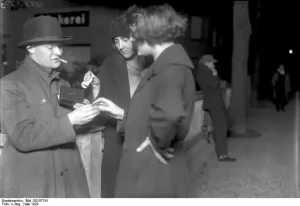
This huge international drug trade headquartered in Saint Petersburg Russia was dominated by organized crime, and more particularly by Jewish organized crime. It is worth noting here that Russia is still troubled by having relatively short supply lines for heroin importation. Central Asian nations such as Turkmenistan and Tajikistan are huge opium-growing areas, so opium can be easily, quickly, and cheaply imported into Russia through overland routes, which makes the flow of opioids into Russia hard to curtail. With the Jewish Bolsheviks finally firmly ensconced in power within Russia during the 1920s, the international drug trade was safe, or so it seemed at first. The Russian Jewish drug trade thrived under Trotsky and other high-level Jewish Bolsheviks; however, when Joseph Stalin became the leader of the USSR, he chose to move against what he considered to be a grave threat to the Soviet Union.
This grave threat that Stalin moved against was, of course, the Jewish international drug syndicate headquartered in Leningrad. Stalin’s officials put a screeching halt to the international Jewish drug trade headquartered in Leningrad with a crescendo of mass executions by firing squad. From this point forward until the fall of the Soviet Union, drugs were never a serious problem in Russia. However, greater Russia’s drug problem resurfaced with vengeance after the collapse of communism in the 1990s.

Russia’s drug problem returned with such vengeance during the 1990s because Jewish oligarchs moved into a weakened, disorganized, and demoralized Russia with plans to practice old and proven methods of Jewish vulture capitalism. Russia’s economic looting at the hands of Jewish billionaires during the 1990s mirrors the American South’s episode of Jewish vulture-capitalist-looting from the post-Civil-War Reconstruction era. It seems that whenever a nation suffers from a mass-scale tragedy of any type, whether it be a war, a revolution, or a natural disaster — such as a tsunami — this leaves the nation in question weakened for a certain amount of time, and a human body that is exhausted, worn-down, and in a weakened state becomes more vulnerable to opportunistic diseases, so likewise, weakened nations become more prone to the disease of opportunistic Jewish economic looting.
A recent example of this phenomenon in effect was the December 26, 2004 tsunami that hit the Indian Ocean and caused so much damage to the island nation of Sri Lanka. After the tsunami devastated Sri Lanka, mostly Jewish multi-national corporations gallantly volunteered to build Sri Lanka a spiffy new privatized public water system, plus international Jewish banks magnanimously offered Sri Lanka a suite of reconstruction loans — how nice of them!


The South’s Reconstruction era was marked by mass-scale Jewish economic looting that was driven by opportunism, but this era was also marked by huge numbers of White Southerners dying deaths of despair by way of suicide, alcoholism, and of course opioid addiction. It turns out that the Reconstruction Era American South was rife with opioid addiction. It seems that episodes of opportunistic Jewish vulture capitalism that follow large-scale tragedies are always punctuated with an influx of deleterious drugs of one type or another, and opioids seem to be the most persistent of these imported drugs. Russia’s experience of the 1990s was marked by an accelerated rate of suicides, alcoholism, and opioid addiction, so this period of time was the Russian version of the American South’s Reconstruction Era.
The Jews who survived Stalin’s drug trade purges in St. Petersburg fled to more hospitable climates, which turned out to be the German Weimar Republic’s fine city of BERLIN! Under the Weimar Republic, Berlin began to occupy the same position within the Jewish international drug trade that was formerly held by St. Petersburg/Leningrad.
Only after Adolf Hitler came to power did the center of the Jewish international drug trade shift to the United States and later to Britain as well. Meyer Lansky and his American Jewish organized crime syndicate established the American drug trade as a virtual Jewish monopoly. It is well known that during the Vietnam War, the CIA was running the drug trade in heroin within and outside of Southeast Asia. What is much less well known is that the CIA was actually working in partnership with Jewish organized crime syndicates (aka The Meyer Lansky Syndicate) in what was a shockingly lucrative business.
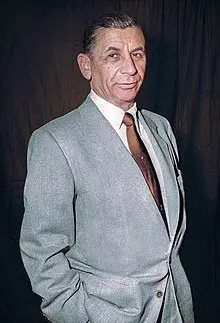
Image of Mayer Lansky in 1958 furnished courtesy of wikipedia.org
The Hollywood movie starring Denzel Washington called American Gangster outlines some facets of America’s massive heroin trade that brought massive amounts of opioids grown in Southeast Asia into America’s cities, but predictably, this Jewish-produced and Jewish-screen-written Hollywood film never mentions Jewish involvement in this particular drug trade. The CIA’s Vietnam-War-Era heroin trade was massively lucrative; however, this rotten drug trade also killed untold numbers of people and left an unthinkable trail of misery in its wake — mass-scale drug trades always leave huge numbers of people dead and crippled, plus these massive drug-moving operations always inflict an unknowable amount of personal, suffering, tragedy, and misery.
The Basic Drug Policy of The Third Reich
When Adolf Hitler and the NSDAP assumed power, they immediately moved against the Jewish-monopolized drug trade that was centered in Berlin. Like Stalin had done before him, within much less than a year, the Third Reich had also cleaned up Berlin’s huge Jewish drug trade. It is most instructive to note how The Great One and his political party chose to deal with Germany’s large number of opioid addicts in Germany in general, and within Berlin in particular, that were present when the NSDAP came to power. (“We shall be kind when we can and hard when we must.” – Reinhard Heydrich.)
In response to Germany’s high number of drug addicts, The National Socialist State set up drug rehabilitation centers everywhere they were needed. It is worth noting that cocaine use was officially outlawed in Germany beginning in 1924, but during the Weimar years large German cities were still noted for their easy flow of cocaine imported from Peru and the Dutch East Indies. Indeed, the Weimar republic is notorious for its degeneracy and drug use; however, what many people fail to realize is that most of the degeneracy and drug use during the Weimar years never made its way to rural areas in Germany. These drug treatment centers that were created by the Third Reich were the first drug rehabilitation centers anywhere in the world, and this model for drug rehabilitation has been exported pretty much everywhere these days. When the Third Reich assumed leadership of Germany, it became mandatory for all drug addicts to enter one of these new drug treatment centers. This state-mandated drug treatment was also given free of charge, and this treatment was provided by employees of The State (doctors, nurses, counselors, etc.)

Once rehabilitation programs were completed, former opioid addicts were released without restrictions back into society. However, if they relapsed and went back on opioids again, they were sentenced to limited periods of time in labor camps where they worked and underwent rehabilitation once again. Once they finished their second rehabilitation cycle along with time in labor camps, these more recalcitrant drug addicts were once again released without restriction back into society. Should any of these truly restive drug addicts relapse once again after serving a second stint of time in a drug rehabilitation center, then going for a round of forced hard labor, then they were from that point forward considered Habitual Criminals and they were sentenced to LIFETIMES OF HARD LABOR in dedicated Labor Camps.

Use of Methamphetamines in the Military of the Third Reich
The kind of Methamphetamine that was developed for use by the armed forces of the Third Reich is called PERVATIN. Pervatin really should not be equated with the well-known products of contemporary “Meth Labs” in the United States. Pervatin was developed only for very limited and specific purposes, and it Did Not Turn People into Berserk Meth Heads, like the present-day products of meth labs are known to do. Pervatin was made to counteract the temporarily effects of fatigue and/or hunger in emergency combat situations. Sustained use of Pervatin was known to result in addiction, so abusing this drug was strictly prohibited and severely punished by court martials and by time in labor camps, and no excuses were accepted for addiction to Pervatin. It was also well-known that using Pervatin while one was experiencing blood loss from wounds was very likely to cause a fatal heart attack because consuming Pervatin causes a significant rise in blood pressure. These were the dangers associated with use of the Third Reich’s Pervatin.
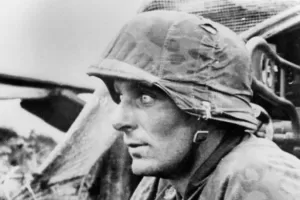
I will give a couple of brief examples to illustrate Pervatin’s authorized use.
During periods of severe and sustained combat on the Eastern Front, as so often happened, men were prevented from getting needed rest and nourishment. Therefore, they would often take Pervatin tablets that they were issued to temporarily keep going. Day Fighter and Night Fighter Aircrews who were defending the German homeland from Allied bombers often had to stay alert and active for long periods of time, and during these trying times, these men would take Pervatin tablets as needed if (((Allied))) bomber activity was particularly heavy and widespread.
Individual defensive sorties against bomber squadrons were not usually all that long, but the time between these combat flights was frequently very short, so German pilots often needed to land and refuel their airplanes and then be ready to take off again as soon as possible. Thus, during periods of heavy bombing, a German combat pilot had to stay in his airplane for long periods of time, and if this poor fellow was lucky, then his crew chief would hand him a sandwich and a cup of coffee to consume as he waited those all-too-few minutes until he had to be airborne again. In such circumstances, German combat airplane pilots sometimes felt the need to take the occasional Pervatin tablet when they were feeling particularly run down.

Conclusion
There is simply no genuine evidence of German methamphetamine abuse during World War II from any Allied sources including the Americans, the British, the French, and the Russians, and not from anybody else. This allegation of widespread German methamphetamine abuse during World War II has only made its appearance in recent times.
When pondering the question of whether the Third Reich’s army were all spun out on meth during World War II, just think about the technical complexity of World War II era combat, especially when it came to operating many state-of-the-art weapons systems from that time, such as operating the combat systems used in aerial warfare. The idea that the armed forces of the Third Reich were so successful because everybody was high on Meth is simply ludicrous in the extreme.

Then there are the tales of the leadership of the 3rd Reich being “Meth Heads.” Again, these are simply base accusations made with no verifiable proof offered. As for the question of who is responsible for all of this slanderous nonsense, (((this much is simple.))) Stories about “Nazis” who were spun out on meth are examples the Jews once again engaging in the psychological manipulation of the gullible masses, but the Jews are also spinning these tall tales of tweaking “Nazis” to deflect attention away from their complicity in the international drug trade in the 1930s and during World War II, which they have always dominated.
Heil Hitler deva!
Randall Lee Hilburn
Postscript Part 1. The Nature or Pervatin
Jew propagandists take advantage of most people’s ignorance of the fact that methamphetamines are actually a family of more-or-less closely related chemical compounds; therefore, there is more than one kind of amphetamine, with some being much worse for their users than others.
Pervitin, which was the specific compound used by the Third Reich, was developed for use in the military. The potential drawbacks of Pervatin’s use, which I previously talked about, could not be avoided, but neither could anything better for the purpose at hand be found.
The product of current American meth labs is a different sort of methamphetamine altogether since the motive of present-day meth cookers is first and foremost to make profits; therefore, the mass production of meth is kept as cheap, quick, and simple as possible, especially considering that those who are cooking meth illegally is also trying to stay one step ahead of the law at all times. Cooking illegal meth using questionable ingredients and hasty methods results in the well-known type of meth that makes people violently crazy.

Unlike present-day illegal meth, Pervitin was produced in a carefully controlled laboratory setting which sits in marked contrast the meth labs that are operated in an exceedingly reckless manner; these dangerous and illegal meth labs are also very so prone to exploding and catching fire. Illegal meth labs are also notorious for incinerating their proprietors in the process of exploding or catching fire.

While I have many ran across references to the use of Pervitin many times in wartime accounts by German Veterans of World War II, most of what I know about Pervatin came from a discussion about Pervitin given by a former Luftwaffe Pilot.
This Luftwaffe’s pilot told a story about an aerial dogfight he got into with an American P-51 Mustang fighter. During the course of this aerial battle, an American 50-cal round ricocheted off of the Luftwaffe pilot’s airplane engine and struck him in the chest. After being struck in the chest, this German pilot started bleeding profusely, so he dived into a nearby cloud where was able to finally lose the American Mustang. After losing the P-51, the German pilot was getting weaker and weaker from loss of blood as he tried to make his way back to base, but he could not bail out of his aircraft because the cockpit canopy was damaged and jammed shut, and while this was happening, the German pilot doubted that he would be able to stay alert long enough to fly back to his base, yet he did have a box of Pervitin tablets (4 or 5) with him. The wounded German pilot knew that he was not supposed to take more than one Pervatin tablet at a time, but considering his growing weakness, he chose to take a gamble with his life, so he downed the whole box of Pervatin in hopes that these potent little tables would at least keep him going until he could land his aircraft.

Immediately after downing the box of Pervatin pills, the German pilot could feel his heart start racing and his blood pressure going through the roof, and as his heart began to race and his blood pressure began to soar, he also began to sweat profusely. It was at this point the he became convinced that he was about to die, however, he managed to keep going until he was able to land back at his base. After landing, he was immediately pulled from his airplane and an ambulance rushed him to the base hospital. The response of the attending surgeon was:
“You damned fool, it was a miracle you didn’t give yourself a heart attack!” “There is a good reason that people are told not to take more than one Pervitin at a time, especially if they are wounded.” “Blood loss speeds up and magnifies the effects of Pervitin. “By rights I should report this, but I’m not going to because I think you have learned your lesson.”
As the former pilot admitted, he most definitely had.
This story perfectly illustrates the actual effects of OD-ing on Pervitin. Going berserk not being one of them.
88!
Randall
Postscript Part 2. Was Hitler Strung Out on Meth During the Final Days of the Third Reich?
For some years now, rumors have been circulating around alleging that Adolf Hitler was strung out on methamphetamines during the final days of World War II. First let it be said that the July 20, 1944 bomb blast in Hitler’s staffroom at his eastern Wolf’s Lair headquarters in what is today Poland may not have killed him, but from that point onward he suffered from debilitating spasms and nervous ticks. Hitler suffered from spasms, tremors, and nervous ticks in the later part of World War II on account of taking damage to his nervous system from the powerful July 20 bomb blast, and Hitler never really recovered from this attempt on his life, so he was never the same again after having survived that most successful assassination attempt. Several sources note that film clips of Hitler after the July 20 assassination attempt do show his hands shaking with Parkinson’s-Disease-like symptoms, but Hitler’s shaking hands were most likely a result of the bomb blast, not methamphetamines.

Image courtesy of wojakparadise.net
No doubt, photos of Adolf Hitler during the final months of World War II do not present a man who looked physically or emotionally well, but in light of what was happening during the final months of World War II, this should come as no surprise. No doubt, during the final months of World War II, Adolf Hitler was forced to witness any hopes he might have harbored about creating a better society and a better world slowly disappear, and this had to have taken a tremendous emotional toll on him.
During the final months of World War II, Hitler was also forced to witness his beloved nation maliciously reduced to rubble by Jewish-controlled adversaries, and this state of affairs also must have taken a terrible emotional toll on him. The July 20 plot against his life also left Hitler even more distrustful than ever of those around him, so Hitler felt a strong need to make every military decision himself, and for understandable reasons, but the continual fear and mistrust he felt for those around him took its toll on him emotionally and spiritually. We should also mention that one key reason for the Third Reich’s military defeat was traitors in its midst, and the issue of traitors surrounding Hitler at all times predates the July 20 attempt on his life, so Hitler had many reasons to be distrustful. Let it be said that Hitler was emotionally and physically unwell during final days of World War II; right, but does this prove that he was strung out on methamphetamines?

It seems that the most prominent voice claiming that Adolf Hitler was using methamphetamines during the final days of World War II is the German author named Norman Ohler. The 2017 book titled Blitzed: Drug in the Third Reich is Ohler’s most well-known publication to date. Ohler’s book Blitzed discusses drug use during the Third Reich, but according to a 2017 article featured in Newsweek Magazine that was written by Stav Ziv, about half of Oherl’s book Bitzed is devoted to Adolf Hitler’s alleged drug addictions. In his book, Ohler alleges that Dr. Theodore Morell, who was Hitler’s personal physician beginning in 1936, started giving Hitler injections of vitamins to improve his health and work performance before the onset of World War II, but later, after surviving the July 20 bomb blast, Dr. Morell gave Hitler injections of such things as cocaine and adrenal extract from pig livers. A New York Times piece from march of 2017 written by Dagmar Herzon also notes that Olher’s book describes Dr. Morell giving Hitler injections mixed from a base of about 80 different substances, but the oxycodone-based opioid named Eukodal was listed as Morell’s primary medication for Hitler.

Not surprisingly, even the New York Times article written by Dagmar Herzon is skeptical of Ohler’s assertions and Herzon questions the veracity of Ohler’s claims that he read Dr. Morell’s personal notes concerning his medical care for Adolf Hitler. According to the previously mentioned Newsweek article about Ohler’s book, even fairly mainstream historians such as Nikolaus Wachsmann, who is a history professor at Birkbeck College in the University of London, have very publicly denounced Ohler’s book as false information. The respected British university professor and author Richard J. Evans also very publicly denounced Ohler’s book for being fanciful and politically loaded misinformation soon after is was published and released.
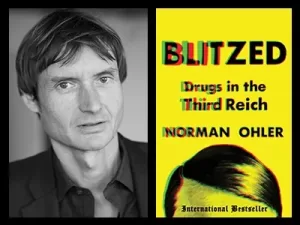
Ohler claims that he uncovered Morell’s notes after spending years looking through old German government documents from the Third Reich while working in partnership with the German historian Hans Mommsen. Mr. Mommsen made a name for himself by being a historian who claimed that the Third Reich was not really a cult of personality surrounding Hitler. Mommsen asserted that Hitler did not bamboozle or hornswoggle a gullible German public; but instead, Mommsen asserts that the Third Reich’s very existence was a case of complete collective guilt that should righteously be plastered all over every German man, woman, child, cat, dog, and livestock animal that was living on that patch of real estate during Hitler’s chancellery. Needless to say, Mommsen’s mantras pouring the sauce of German guilt on the Third Reich’s alleged crimes made him a popular fellow in post-World War II German academia because he was parroting the kind of talk the new post-war (((Allied))) establishment wanted to hear. Let us face fact, there was — and there still is — simply no place for unrepentant historical narratives concerning the Third Reich coming from German academics, and things have been this way from 1945 to the present.
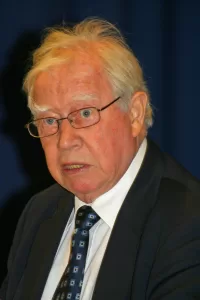
It seems that Olher is simply fabricating information for personal political gain when he wrote Blitzed because he knows that attacking the Third Reich and National Socialism was, and still is, a good way to win the German establishment’s favor in the post-World-War II years. It is also worth noting that Oher’s Wikipedia page mentions that he has spent time living in Jerusalem and Tel Aviv as ” A Writer in Residence,” so these pieces of information pretty much tell us all what we need to know concerning where Ohler really stands politically and who he really serves. It seems that Ohler is a sycophant to Jewish oligarchs and Jewish institutional power in general, so we should not interpret his attacks against the Third Reich on face value.
The excerpt below is taken directly from the March 2017 Newsweek article written by Stav Ziv:
His grandfather’s nostalgia for the “order” of Germany’s darkest era—which Ohler says was common in 1980s West Germany—made him angry. As a teenager, he began hating Germany. He adopted leftist views and “looked for ways to resist right-wing developments,” he says. “[There’s] a slogan we have in Germany. It’s also a cliché in a way too, but it’s like, we have to do everything we can so that something like this doesn’t happen again.” He decided that what he could do was to become a writer and journalist “to uncover bad things in society and help the democratic process.”
To directly quote another passage in Ziv’s Newsweek article about Ohler and his book Blitzed:
He describes the “strict, ideologically underpinned anti-drug policy with propagandistic pomp and draconian punishments” as “a vehicle for the exclusion and suppression, even the destruction, of marginal groups and minorities.” The Nazis drug policies, he argues, were deeply linked to anti-Semitism. Their “war on drugs,” he tells Newsweek, is a “highly problematic concept” that didn’t disappear with the Third Reich, pointing to the image of African immigrants in more recent years in Germany and to U.S. “war on drugs” policies that disproportionately targeted African-Americans. Having watched Ava DuVernay’s Oscar-nominated documentary 13th midway through reading Blitzed, Ohler’s comparison felt relevant. The parallels are not exact but are nevertheless difficult to ignore.
So, in light of the two paragraphs lifted directly from Ziv’s Newsweek article about Ohler and his book, we can conclude that Olher is at least publicly in favor of bringing more African migrants into Germany and he is in favor of promoting very loose and permissive laws concerning how to manage hard drugs. We can also conclude that Olher also pretty much hates and despised his own people and he just might truly believe all of the vilification propaganda leveled against Hitler and the Third Reich by Jews. Ohler also just might actually know better concerning the true history of the Third Reich, but it seems that he is completely unwilling to risk his wealth and his approval from the Jewish establishment by politically rocking the boat.
In summary, it is hard to know if Adolf Hitler was really strung out on drugs during the last months of World War II, but it does seem that the people who push this narrative certainly have a political agenda. Another set of unpleasant questions has to be asked in this case: Even if Adolf Hitler was using drugs during the last months of World War II, does this invalidate all of the work he did previously? Also, even if Hitler was strung out on methamphetamines and opioids during the final months of World War II, does this totally destroy the ideas underpinning National Socialism? Every one of us must decide these questions on our own.






